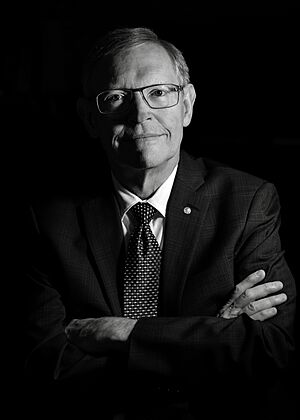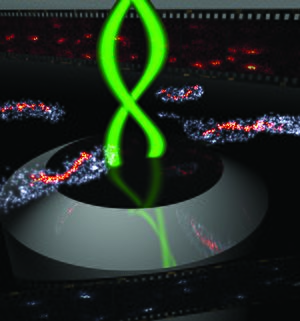William E. Moerner facts for kids
Quick facts for kids
William E. Moerner
|
|
|---|---|

Moerner in 2024
|
|
| Born |
William Esco Moerner
June 24, 1953 Pleasanton, California, U.S.
|
| Alma mater | |
| Awards | Wolf Prize in Chemistry (2008) Irving Langmuir Award (2009) Peter Debye Award (2013) Nobel Prize in Chemistry (2014) |
| Scientific career | |
| Fields | Chemistry, applied physics, biophysics |
| Institutions | |
| Thesis | Vibrational relaxation dynamics of an IR-laser-excited molecular impurity mode in alkali halide lattices (1982) |
| Doctoral advisor | Albert J. Sievers |
| Other academic advisors | James Gegan Miller |
William Esco Moerner, also known as W. E. Moerner, is an American scientist born on June 24, 1953. He is a physical chemist and chemical physicist. His work focuses on biophysics and looking at single molecules.
He is famous for being the first to see and study a single molecule using light. He did this with his colleague, Lothar Kador. This discovery was a big step forward in science. It helped create new ways to study tiny particles in chemistry, physics, and biology. In 2014, he won the Nobel Prize in Chemistry for his amazing work.
Early Life and Education
William Esco Moerner was born in Pleasanton, California. He grew up in Texas. His family called him W. E. to tell him apart from his father and grandfather, who were also named William.
He went to Thomas Jefferson High School in San Antonio. He was very active in school, joining the band, debate team, and science clubs. He was also a Boy Scout.
For college, he attended Washington University in St. Louis. He earned three degrees in 1975: one in physics, one in electrical engineering, and one in mathematics.
He then went to Cornell University for his advanced studies. He earned his master's degree in 1978 and his Ph.D. in physics in 1982. His Ph.D. research was about how molecules relax after being excited by a laser.
Career Highlights
After finishing his studies, Moerner worked at the IBM Almaden Research Center in California from 1981 to 1995. He started as a researcher and later became a manager and project leader.
From 1995 to 1998, he was a professor at the University of California, San Diego. In 1998, he moved to Stanford University. There, he became a professor of chemistry and applied physics. He also led the chemistry department from 2011 to 2014.
What He Studies
Moerner's research focuses on several exciting areas:
- Single-molecule spectroscopy: This means studying one molecule at a time.
- Super-resolution microscopy: This is a special type of microscope that can see things in much greater detail than regular microscopes.
- Biophysics: This field uses physics to understand living things.
- Nanophotonics: This involves studying how light interacts with very tiny materials.
Awards and Recognition
W. E. Moerner has received many important awards for his scientific work. Some of these include:
- The Wolf Prize in Chemistry in 2008.
- The Irving Langmuir Award in Chemical Physics in 2009.
- The Peter Debye Award in Physical Chemistry in 2013.
- The Nobel Prize in Chemistry in 2014.
He is also a member of important groups like the National Academy of Sciences. He holds more than ten patents for his inventions.
See also
 In Spanish: William E. Moerner para niños
In Spanish: William E. Moerner para niños


